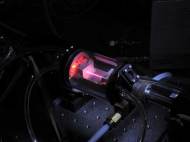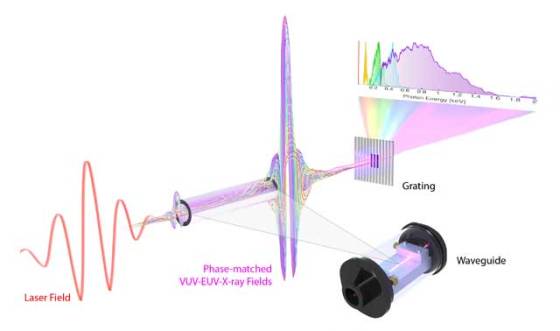First tabletop X-ray laser device
 Most of today’s X-ray lasers require so much power that they rely on facilities the size of football stadiums or larger, making their use impractical. An international research team led by researchers from the University of Colorado Boulder (CU Boulder) has generated the first laser-like beams of X-rays from a tabletop device, thus enabling more widespread use of the technology.
Most of today’s X-ray lasers require so much power that they rely on facilities the size of football stadiums or larger, making their use impractical. An international research team led by researchers from the University of Colorado Boulder (CU Boulder) has generated the first laser-like beams of X-rays from a tabletop device, thus enabling more widespread use of the technology.
Laser beams, which are visible light, represent one of the best ways to concentrate energy and have been a huge benefit to society by enabling the Internet, DVD players, laser surgery and a host of other uses.
“However, the same revolution that happened for visible light sources that made it possible to create laser-like beams of light for widespread use instead of multidirectional light from a light bulb, is only now happening for X-rays”, said Henry Kapteyn, a CU-Boulder physics professor and fellow at JILA, a joint institute of CU-Boulder and the National Institute of Standards and Technology.
Researchers used a technique first discovered in the late 1980s called high-harmonic generation (HHG). The tabletop device uses atoms in a gas to efficiently combine more than 5,000 low-energy mid-infrared laser photons to generate each high-energy X-ray photon. This enables utilization of less power demanding lasers with relatively long wavelengths (~4 microns) to be combined to produce X-rays with short wavelengths.
The tabletop device, which is basically an X-ray tube able to achieve high photon energies that span from the ultraviolet into the soft X-ray region, produces a bright, directed beam of X-rays by ensuring that all of the atoms in a multi-atmosphere pressure gas emit X-rays.
“Because X-ray wavelengths are 1,000 times shorter than visible light and they penetrate materials, these coherent X-ray beams promise revolutionary new capabilities for understanding and controlling how the nanoworld works on its fundamental time and length scales”, said Margaret Murnane, a CU-Boulder physics professor and JILA fellow who is co-leading this research with
The X-rays generated by the device emerge as very short bursts of light that can be used to capture the fastest processes in known physics. Such short bursts of light could be used to capture processes such as the movement of electrons and atoms inside molecules or materials with nanometer resolution in thick samples in three dimensions – thus allowing scientists to understand the limiting speeds of electronics, energy harvesting, catalysis, or data storage.
CU Boulder researchers hope that they will be able to create a device with even faster X-ray bursts which will be only zeptoseconds (1 zs = 10-21 s) long. For an idea how fast this is, it takes light 350 zs to travel the width of a hydrogen atom, so it would enable observation of processes inside the nucleus of an atom.
Although 3 orders of magnitude less impressive, currently available technology offers a much smaller and less costly alternative to huge and scarce facilities used to perform X-ray tests. Its availability to the larger number of research groups could lead to various advances in many fields including medicine, biology and nanotechnology development.
For more information and a long list of researchers on this project, read the paper published in the journal Science: “Bright Coherent Ultrahigh Harmonics in the keV X-ray Regime from Mid-Infrared Femtosecond Lasers” [3.75MB PDF].










Leave your response!